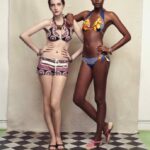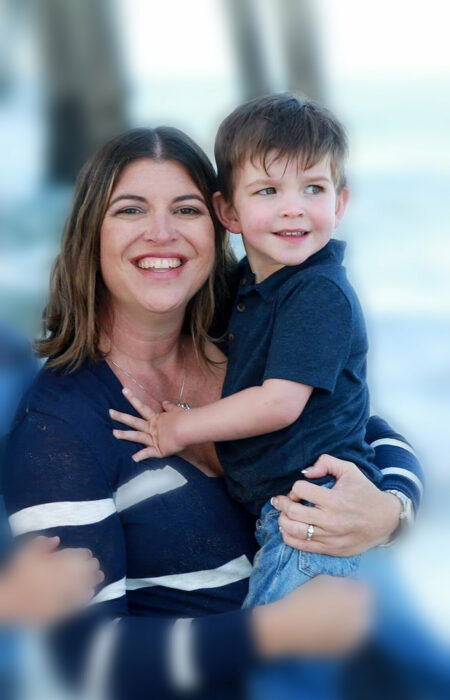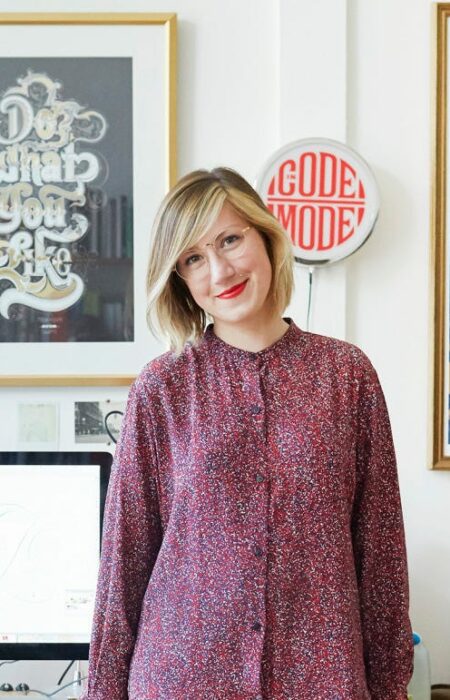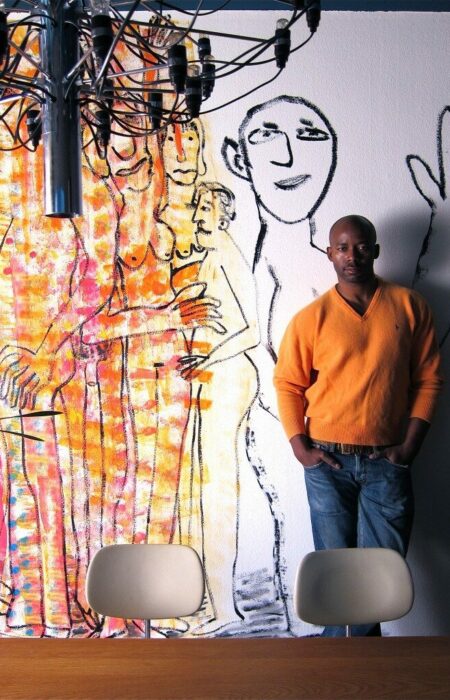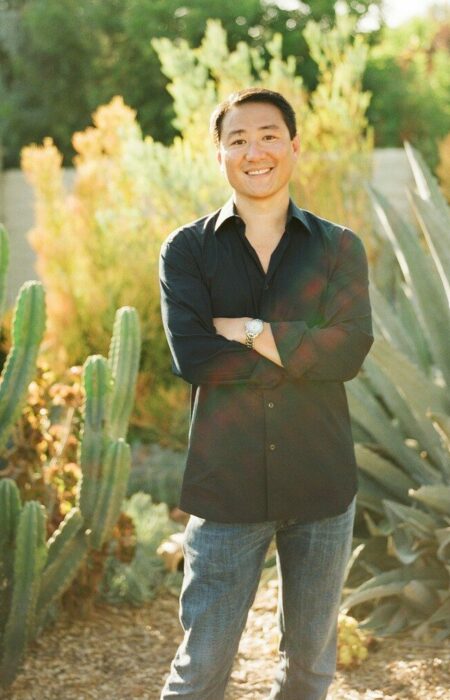Painter Chris Vance‘s art is rooted in a blend of cartoons, music, graffiti, skateboard culture, and the freeform design aesthetic of a teenager. A serious and prolific artist with a laid-back demeanor, Chris works hard at getting out of his own way. His design process is fast, multi-tasking, and ready to do battle with artistic rules. A devoted and involved husband and father of four, Chris shows the same selfless spirit by encouraging his customers to display his work in a way that continues the creative process.
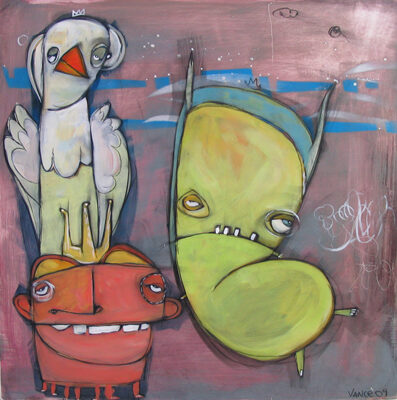
Earth and Space Cowboys by Chris Vance
You’ve developed a pretty distinctive style, with images that are sometimes a cross between scary and cartoonish. How do these ideas come to you?
I have four kids, and I’ve been influenced by skateboards since I was a kid, plus graffiti, cartoons, and the whole Ren and Stimpy type culture. Cartoon characters that aren’t really Tom and Jerry but they’re a little darker than that, I guess. And I’ve always been inspired by the way my kids draw things — kind of sketchy but there’s an interesting line quality that happens when they’re not really aware of making it perfect. All those things kind of intrigue me, all those things kind of crammed into my head and spit back out!
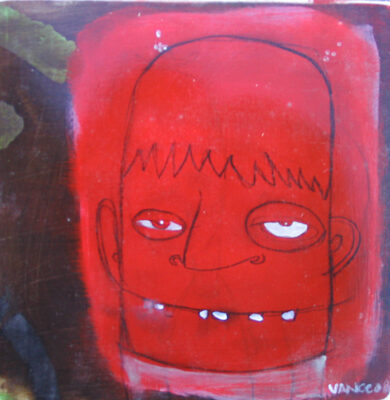
Bully by Chris Vance
Can you tell me a bit about the progression of your work over the years and if you have formal artistic training?
I was kind of advanced when I was younger, and in elementary school was sent to the Des Moines Art Center in town and took a lot of classes there. Then I kind of got away from it for a little while and thought I wanted to be an architect in high school. I went to college and was in the architecture program at Iowa State but realized I didn’t think I was into that and found there wasn’t a lot of free thinking happening. So I found myself in the art and design program, and it seemed like a perfect fit. I graduated from Iowa State in 2000 with a BFA.
The progression actually happened over the last 10 years. When I was in college, I was really influenced by Richard Diebenkorn‘s work and by some of the abstract expressionists. Through that, I keep researching and looking and trying to find new influences. My figurative work kind of just started out as sketches in my sketchbook. I’d kind of gotten away from it in college, because I took figurative drawing and everything had to be perfect and great. I was ok at it but I didn’t really want to draw what you could see with your eye. I’ve always been interested in things that are created and that you really can’t see. Then having the kids around and seeing what they’re thinking, and then some of the new influences I’m seeing that’s happening on the west coast and in graffiti in general.
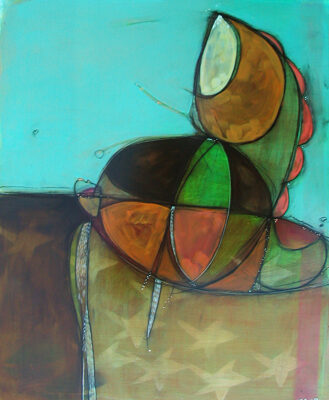
Boozers by Chris Vance
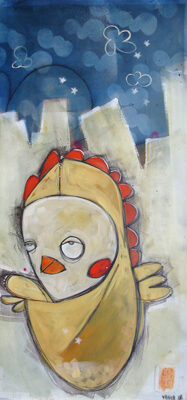
Fhat-Ass Duck by Chris Vance
You talk about how the smallest things in life strike ideas that fuel your work. Can you tell me about those small seeds of inspiration and how you take it from there?
That’s one way the figurative work has helped me express myself more as an artist — day to day happenings. A situation happens, and I end up doing a piece about that. It’s kind of a commentary on society and life, and some day to day events always come back into play in my work. Or someone I come across — like at the auto parts store — somehow they end up in my paintings. And it never really looks like that person, but it’s more about the concept or idea. Whatever happens day to day changes us as people. My art is kind of like my diary.
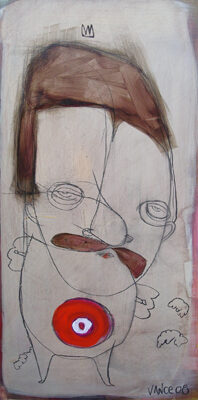
Where I Am Headed by Chris Vance
Do you work exclusively in acrylic, and what is it about this medium that suits you?
I used to paint in oils in college, but I’m very impatient, and acrylic paint dries really fast. I’ll work on a series of maybe 20 pieces of the same size at the same time. I’ll just start a series like that — I don’t just work on one piece at a time. Acrylic is nice because I can do a layer, and a lot of my work is built up through thin layers of washes — kind of like glazing with oil based paints. And I use charcoal too. With oil, it takes so long to dry. By the time I’d be able to get back into it in with the charcoal again, you’re looking at a week or two down the road. With acrylic, you’re talking an hour, and you can start working back on top of that piece. I also in the last 3 years have been really incorporating spray paint into my work. It’s kind of a subtle thing, and a lot of people don’t know it’s there, but it is. It’s like in the 3rd or 4th layer of building up the background of a piece. It’s just a nice subtle thing, but you can kind of pick up a halo effect.
I originally saw your work at an arts festival about a year ago, and the way you display your art on wood pieces of different depths really shows off your work well. How did you come up with this idea?
I’d seen some other artists do it in the past, like Thomas Campbell. And just like this whole street art movement that’s kind of gone mainstream, with the stacking and layering of pieces. And I think it honestly stems back to when I was a kid. I’m a kid of the 80’s and we had rock posters and things. I used to have my bedroom walls covered in rock posters, and I’d write my friends’ phone numbers right on my wall. Just layered it and layered it. Honestly, my studio walls look just like that — pictures of family, pictures of art that I like, my kids’ sketches, layering on top of each other. For some reason, that juxtaposition is intriguing to me, abutting things together that don’t really belong together, but somehow they work.

Gallery ‘overload’ display by Chris Vance
I’ve also noticed your pieces are best appreciated if they are displayed together in a way that allows someone to organize and reorganize your paintings together to make up a larger story.
I’ve had someone describe it as like comic book boxes, like they’re putting together a story. Like this person knows this guy down here, and so on, like their own fairy tale out of the artwork.
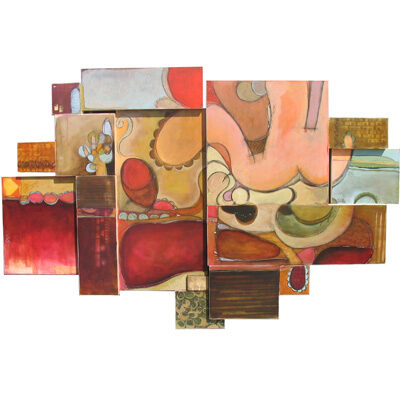
Speedy Catch Me If You Can by Chris Vance
Your sense of color is quite strong. What influences your color choices?
Just the challenge of always pushing the envelope! Like one thing I know for sure I get bored really easily. I’m still part of a critique group in Des Moines called The Paint Pushers. It’s an ongoing battle. I got into using flesh tones for a while because at one critique someone said you should never use flesh tone as a background color. So I took that on as a challenge, like I could make a good painting with flesh as the background color, you know? I’m always intrigued by pushing that envelope. Like why does pink and an acid green and this turquoise color — how does that work, and can you make that work? It seems like every time I make my palette getting ready to start a series of paintings, it’s always evolving. I’ll add 2 or 3 new colors and start making up new colors to complement those colors. It’s an ongoing thing being able to paint with any color palette.
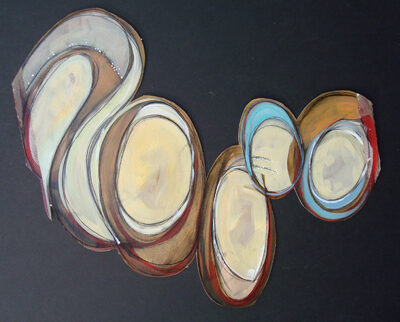
Vance Curved Up by Chris Vance
How much time do you typically devote to each painting, and do you push yourself to keep painting even if you’re not sure where the concept is headed?
I always push myself. A lot of my work bounces back and forth between the non-objective and the figurative work. A lot of people say ‘it’s weird, it doesn’t seem like you have a direction.’ But actually that’s how my mind works — like I can’t just sit down and say ‘OK, I’m going to do 10 figurative pieces.’ I just respond to what happens. I do layer after layer of paint just before I spray paint, before I ever draw a line on it or before it ever becomes anything. It has to have this history there. A lot of it happens spontaneously. That’s how some of them end up non-objective, and some end up figurative. The non-objective ones sometimes are just about line, color, balance. It’s almost like I’m doing a study in basic composition, and that’s just my way of solving certain problems with that particular piece. And others feel like, with this line all of a sudden I see a chin, and here’s the hair, and the next thing you know, I have a figurative piece or a monster or a head with 6 arms and two legs. I don’t really know how it happens!
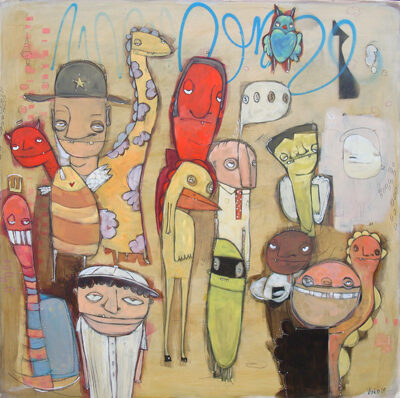
Simple Plans by Chris Vance
Have you always been artistic, and were there turning points along the way that brought you to where you are today?
It was probably my sophomore or junior year in college, and we had our first child. And something clicked in my head, like ‘ok, well, if I’m going to be an artist, and I’m going to have to provide for a family, I’m going to have to get serious about this.’ I was talented at it, but I needed to be a little bit more serious about this. I couldn’t figure out why my sketches were amazing, but my painting always came out flat. Like I’d try to take really great sketches and translate them to the canvas, and I’d work and work on these concepts before I’d ever get out the paint. It was like my mind was trying to Xerox it, and it was boring! Halfway through the piece I wasn’t excited by it anymore, like I was trying to copy something I’d already done. And I had a professor say, ‘you might be one of those rare people who doesn’t need a sketchbook, and your artwork is your sketchbook.’ And that kind of led to the whole diary part of it. Almost all my pieces to me are sketches — I just turned that thought process around. I still sketch concepts, but when I’m in my studio, I just get in there and work. As soon as that changed for me, it had this freshness and it was alive.
I like to ask the people I interview about some of their favorite things, whether they directly impact your work or just make you happy.
First of all, my wife is an amazing cook, and she cares about her food like I care about my artwork. So I’m very well fed! Probably second is music, and I listen to everything. I don’t draw any lines in the sand. And I don’t really call myself a drummer, but I play the drums.


